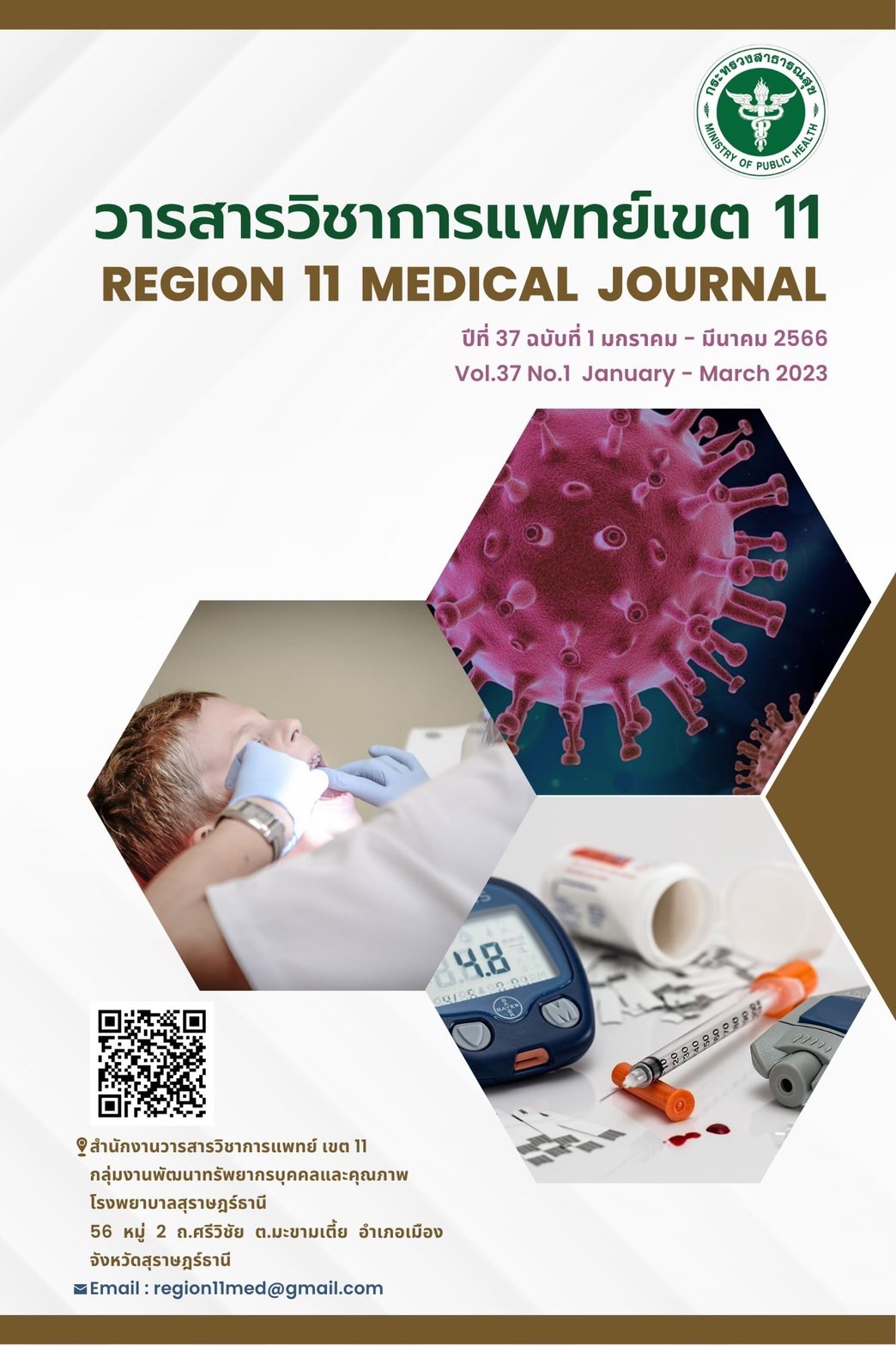Associated factors of cleft lip and/or palate on patients in Vachira Phuket Hospital
Keywords:
cleft lip and cleft palate, cleft lip, cleft palateAbstract
Objective : To describe the epidemiology and factors associated with cleft lip and/or palate on patients in Vachira Phuket Hospital.
Methods : This descriptive study aimed to describe the epidemiology and factors associated with cleft lip and/or palate using data from questionnaire and medical record. The case of 132 patients with cleft lip and/or palate who come to treatment at Vachira Phuket Hospital from 2015 to 2022. Data was collected and analyzed including personal factors, gender, type of cleft lip and/or palate, parental factors, family history and factors during pregnancy.
Results : Among 132 cases, 117 cases were Thai newborns and 15 involved foreign-born residents. The highest proportion were cleft lip and cleft palate (54.5%) followed by cleft palate (23.5%) and cleft lip (12.9%). Cleft lip and/or palate was slightly higher among females (53.8%). Patients with cleft lip and/or cleft palate were more frequently first-born (37.9%). There were 8 cases (6.1%) of syndromic cleft lip and/or palate. There was 20.5% of patients that have family history of cleft lip and/or cleft palate. The patients (1.5%) were their parents were consanguineously married. There is a statistically significant correlation between kinds of cleft lip and cleft palate and birth order (P=0.009)
Conclusion : The highest proportion were cleft lip and cleft palate followed by cleft palate and cleft lip. All 3 types of cleft lip and/or palate were found in females more than males. Patients with cleft lip and/or cleft palate were more frequently first-born. A scientifically significant relationship was discovered between cleft lip and cleft palate and the kid born after the first.
References
Godfrey K, Chowchuen B. Investigating the occurrences of cleft lip, cleft palate and other related birth defects. Srinagarind Med J 2001;16(1): 27-36.
Pradubwong S, Pongpagatip S, Prathanee B, Thanawirattananit P, Ratanaanekchai T, Chowchuen B. The treatment of 4-5 year-old patients with cleft lip and cleft palate in Tawanchai Center: follow-up. J Med Assoc Thai 2012; 95 Suppl 11: S135-40.
Chowchuen B, Thanaviratananich S, Chichareon V, Kamolnate A, Uewichitrapochana C, Godfrey K. A multisite study of oral clefts and associated abnormalities in Thailand: The epidemiologic data. Plast Reconstr Surg Glob Open 2015; 3(12): 1-7.
Yaqoob M, Mahmood F, Hanif G, Bugvi SM, Sheikh MA, Etiology and genetic factors in clefts of lip and/or palate reported at children’s hospital, Lahore, Pakistan. Indian J Hum Genet 2013; 19(2): 136-43.
Watkins SE, Meyer RE, Strauss RP, Aylsworth AS. Classification, epidemiology, and genetics of orofacial clefts. Clinics in Plastic Surgery 2014; 41(2): 149–63.
Detpithak A, Noochpoung R, Yensom N. Incidence of cleft lip and/or cleft palate of live births in Chiangmai from 2015-2019. Th Dent PH J 2020; 25: 41-9.
Mo-suwan L, Chanwitan P, Jarurattanasirikul S, Prathiepchaikul L, Intanon T, Isaranurak S, et al. A review of health status of Thai infants and preschool children. Songkla: National Library of Thailand; 1999.
Chaiworawikul M. Incidence, Etiology and prevention of cleft lip and/or cleft palate. CM Dent J 2012; 33(2): 45-55.
Tisase L. Incidence of cleft lip and/or cleft palate in new born babies in Srisaket hospital between 2005-2007. Medical Journal of Srisaket Surin Buriram Hospitals 2007; 22(3): 417-8.
Jaruratanasirikul S, Chichareon V, Pattanapreechawong N, Sansupavanich P. Cleft lip and/or palate: 10 years experience at a pediatric cleft center in Southern Thailand. Cleft Palate Crainofac J 2008; 45(6): 597-602.
Nahas LD, Alzamel O, Dali MY, Alsawah R, Hamsho A, Sulman R, et al. Distribution and risk factors of cleft lip and palate on patients from a sample of Damascus hospitals-a case-control study. Heliyon 2021; 7(9): e07957.
Jalilevand N, Jalaie S. Prevalence of cleft lip and palate among four provinces in the West and North-West of Iran. J Res Med Sci 2015; 20(6): 548-53.
de Aquino SN, Machado RA, Paranaíba LM, Martelli DR, Popoff DA, Swerts MS, et al. A review of seasonality of cleft births–the Brazil experience. J Oral Biol Craniofac Res 2017; 7(1): 2-6.
Virarat P, Ritthagol W, Limpattamapanee K. Epidemiologic study of oral cleft in Maharatnakornratchasima hospital between 2005-2009. J Thai Assoc Orthod 2010; 9: 3-13.
Theerasopon P, Ritthagol W. Historical social perspective and incidence of cleft lip and/or palate. O J Thai Assoc Orthod 2019; 9(2): 26-32.
Torfs CP, Christianson RE. Anomalies in Down syndrome individuals in a large population‐based registry. Am J Med Genet 1998; 77(5): 431-8.
Thanasansomboon A, Ritthagol W. Pierre Robin Sequence: Current trends in treatment and a case report. O J Thai Assoc Orthod 2018; 8(2): 13-24.
Rajeev BR, Prasad KV, Shetty PJ, Preet R. The relationship between orofacial clefts and consanguineous marriages: A hospital register-based study in Dharwad, South India. Journal of Cleft Lip Palate and Craniofacial Anomalies 2017; 4(1): 3-8.
Cooper ME, Stone RA, Liu YE, Hu DN, Melnick M, Marazita ML. Descriptive epidemiology of nonsyndromic cleft lip with or without cleft palate in Shangai, China, from 1980 to 1989. Cleft Palate Craniofac J. 2000;37(3):274-80.
Vieira AR, Orioli I. Birth order and oral clefts: a meta analysis. Tera tology. 2002;66(4):209-16.
Munger RG, Romitti PA, Daack‐Hirsch S, Burns TL, Murray JC, Hanson J. Maternal alcohol use and risk of orofacial cleft birth defects. Teratology 1996; 54(1): 27-33.
Downloads
Published
How to Cite
Issue
Section
License
Copyright (c) 2023 Region11Medical Journal

This work is licensed under a Creative Commons Attribution-NonCommercial-NoDerivatives 4.0 International License.





